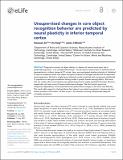Unsupervised changes in core object recognition behavior are predicted by neural plasticity in inferior temporal cortex
Author(s)
Jia, Xiaoxuan; Hong, Ha; DiCarlo, James J
DownloadPublished version (2.160Mb)
Publisher with Creative Commons License
Publisher with Creative Commons License
Creative Commons Attribution
Terms of use
Metadata
Show full item recordAbstract
<jats:p>Temporal continuity of object identity is a feature of natural visual input and is potentially exploited – in an unsupervised manner – by the ventral visual stream to build the neural representation in inferior temporal (IT) cortex. Here, we investigated whether plasticity of individual IT neurons underlies human core object recognition behavioral changes induced with unsupervised visual experience. We built a single-neuron plasticity model combined with a previously established IT population-to-recognition-behavior-linking model to predict human learning effects. We found that our model, after constrained by neurophysiological data, largely predicted the mean direction, magnitude, and time course of human performance changes. We also found a previously unreported dependency of the observed human performance change on the initial task difficulty. This result adds support to the hypothesis that tolerant core object recognition in human and non-human primates is instructed – at least in part – by naturally occurring unsupervised temporal contiguity experience.</jats:p>
Date issued
2021Department
Massachusetts Institute of Technology. Department of Brain and Cognitive Sciences; McGovern Institute for Brain Research at MIT; Harvard University--MIT Division of Health Sciences and Technology; Center for Brains, Minds, and MachinesJournal
eLife
Publisher
eLife Sciences Publications, Ltd
Citation
Jia, Xiaoxuan, Hong, Ha and DiCarlo, James J. 2021. "Unsupervised changes in core object recognition behavior are predicted by neural plasticity in inferior temporal cortex." eLife, 10.
Version: Final published version